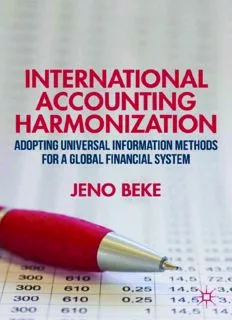
International Accounting Harmonization: Adopting Universal Information Methods for a Global Financial System PDF
Preview International Accounting Harmonization: Adopting Universal Information Methods for a Global Financial System
International Accounting Harmonization This page intentionally left blank International Accounting Harmonization Adopting Universal Information Methods for a Global Financial System Jeno Beke INTERNATIONAL ACCOUNTING HARMONIZATION Copyright © Jeno Beke, 2013. Softcover reprint of the hardcover 1st edition 2013 978-1-137-37530-8 All rights reserved. First published in 2013 by PALGRAVE MACMILLAN® in the United States—a division of St. Martin’s Press LLC, 175 Fifth Avenue, New York, NY 10010. Where this book is distributed in the UK, Europe and the rest of the world, this is by Palgrave Macmillan, a division of Macmillan Publishers Limited, registered in England, company number 785998, of Houndmills, Basingstoke, Hampshire RG21 6XS. Palgrave Macmillan is the global academic imprint of the above companies and has companies and representatives throughout the world. Palgrave® and Macmillan® are registered trademarks in the United States, the United Kingdom, Europe and other countries. ISBN 978–1–349–47730–2 ISBN 978–1–137–37434-9(eBook) DOI 10.1057/9781137374349 Library of Congress Cataloging-in-Publication Data is available from the Library of Congress. A catalogue record of the book is available from the British Library. Design by Newgen Knowledge Works (P) Ltd., Chennai, India. First edition: December 2013 10 9 8 7 6 5 4 3 2 1 Contents List of Illustrations vii 1. Introduction 1 Previous Related Literature: A Review 6 2. Classification of Accounting Systems 11 European Accounting System 15 US GAAP 21 International Accounting Standards 44 International Accounting Organizations 48 Hungarian Accounting System 54 3. The Influencing Factors of Accounting Harmonization 73 Legal System 74 Financing Methods 75 Taxation System 76 Inflation 77 4. Problems Caused by Accounting Diversity 79 Preparation of Consolidated Financial Statements 79 The Universal Information Methods’ Role in Performance Assessment 80 Access to Foreign Capital Markets 82 Lack of High-Quality Accounting Information 82 5. Economic Factors of Accounting Harmonization 85 Role of International Accounting Harmonization in the Division of Labor 85 vi Contents International Accounting Harmonization and Financial Innovation 88 The Effects of International Accounting Harmonization on the Transaction Costs 90 International Accounting Harmonization Decreases Costs of Capital 94 6. Comparative Statistical Analysis 99 The Accounting Peculiarities of the Member States of the European Union 100 The Accounting Peculiarities of Countries Outside of the European Union 109 Evaluation of Certain Accounting Standards 112 7. Effects of Universal Information Methods on Company Performance 119 Universal Accounting Methods and Company Performance Effects 125 Universal Accounting Methods and Earnings Management 129 Universal Accounting Methods and P&L Effects 132 Universal Accounting Methods and Value Relevance 133 Empirical Results 137 Discussions 139 8. International Accounting Standardization Process 147 Basic Features and Methods of the Empirical Research 148 Findings and Evaluation 151 9. Summary and Conclusions 161 References 171 Index 175 Illustrations FIGURES 6.1 Differences between domestic accounting rules and the IAS in the EU 102 6.2 Differences between domestic accounting rules and the IAS outside of the EU 109 6.3 Differences between domestic accounting rules and the IAS by standards 113 TABLES 2.1 US GAAP categories 22 7.1 Logistic analysis of universal information methods adoption decisions 122 7.2 CEO turnover-to-performance sensitivity analysis 124 7.3 Employee layoff-to-performance sensitivity analysis 126 7.4 Company performance effects 128 7 .5 U niversal methods and earnings management 1 31 7.6 Universal method effects 134 7.7 Small profit or large losses 135 7.8 Universal methods and value relevance 136 8.1 Companies in the sample by industry and type of accounts 149 8.2 Companies in the sample and the entire population by industry 1 50 viii Illustrations 8.3 Description of the indicators used for this study 151 8.4 Results describing the indicators under review, compared by the type of accounts 152 8.5 Classification table for the logistic regression model 157 8.6 Results for explanatory variables 158 1. Introduction Nowadays, especially during the current global financial crisis, companies are striving desperately to remain competitive and achieve sustainable levels of economic development. The highly competitive environment requires companies to create a clear business strategy, and accounting has to be part of this strategy since it helps individual enterprises to achieve their strate- gic objectives. International accounting standards are new global methods for business information systems and they are able to harmonize financial regimes worldwide. The increased globalization of markets, the complexity of com- mercial trading, and the concentration of business in global competition have led to a still greater need for international harmonization. In today’s business environment, companies need to make use of every advantage available to remain competi- tive. Global competition, rapid innovation, entrepreneurial competitors, and increasingly demanding customers have altered the nature of competition in the marketplace. This new competitive environment requires companies’ ability to create value for their customers and to differentiate them- selves from their competitors through the formulation of a clear business strategy. Business strategy must be supported by appropriate organizational factors such as effective man- ufacturing process, organizational design, and accounting information systems. J. Beke, International Accounting Harmonization © Jeno Beke 2013
